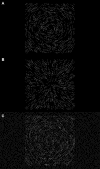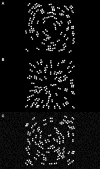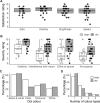Improving Understanding of Visual Snow by Quantifying its Appearance and Effect on Vision
- PMID: 38787547
- PMCID: PMC11129720
- DOI: 10.1167/iovs.65.5.38
Improving Understanding of Visual Snow by Quantifying its Appearance and Effect on Vision
Abstract
Purpose: Visual snow is the hallmark of the neurological condition visual snow syndrome (VSS) but the characteristics of the visual snow percept remain poorly defined. This study aimed to quantify its appearance, interobserver variability, and effect on measured visual performance and self-reported visual quality.
Methods: Twenty-three participants with VSS estimated their visual snow dot size, separation, luminance, and flicker rate by matching to a simulation. To assess whether visual snow masks vision, we compared pattern discrimination thresholds for textures that were similar in spatial scale to visual snow as well as more coarse than visual snow, in participants with VSS, and with and without external noise simulating visual snow in 23 controls.
Results: Mean and 95% confidence intervals for visual snow appearance were: size (6.0, 5.8-6.3 arcseconds), separation (2.0, 1.7-2.3 arcmin), luminance (72.4, 58.1-86.8 cd/m2), and flicker rate (25.8, 18.9-32.8 frames per image at 120 hertz [Hz]). Participants with finer dot spacing estimates also reported greater visibility of their visual snow (τb = -0.41, 95% confidence interval [CI] = -0.62 to -0.13, P = 0.01). In controls, adding simulated fine-scale visual snow to textures increased thresholds for fine but not coarse textures (F(1, 22) = 4.98, P = 0.036, ηp2 = 0.19). In VSS, thresholds for fine and coarse textures were similar (t(22) = 0.54, P = 0.60), suggesting that inherent visual snow does not act like external noise in controls.
Conclusions: Our quantitative estimates of visual snow constrain its likely neural origins, may aid differential diagnosis, and inform future investigations of how it affects vision. Methods to quantify visual snow are needed for evaluation of potential treatments.
Conflict of interest statement
Disclosure:
Figures







References
-
- Schankin CJ, Maniyar FH, Digre KB, Goadsby PJ.. “Visual snow” - a disorder distinct from persistent migraine aura. Brain. 2014; 137(5): 1419–1428. - PubMed
-
- Hu KS, Martindale C, Cortez MM, Digre KB.. Visual quality of life in patients with visual snow syndrome. Cephalalgia. 2021; 41(Suppl 1): 95.
MeSH terms
Supplementary concepts
LinkOut - more resources
Full Text Sources

